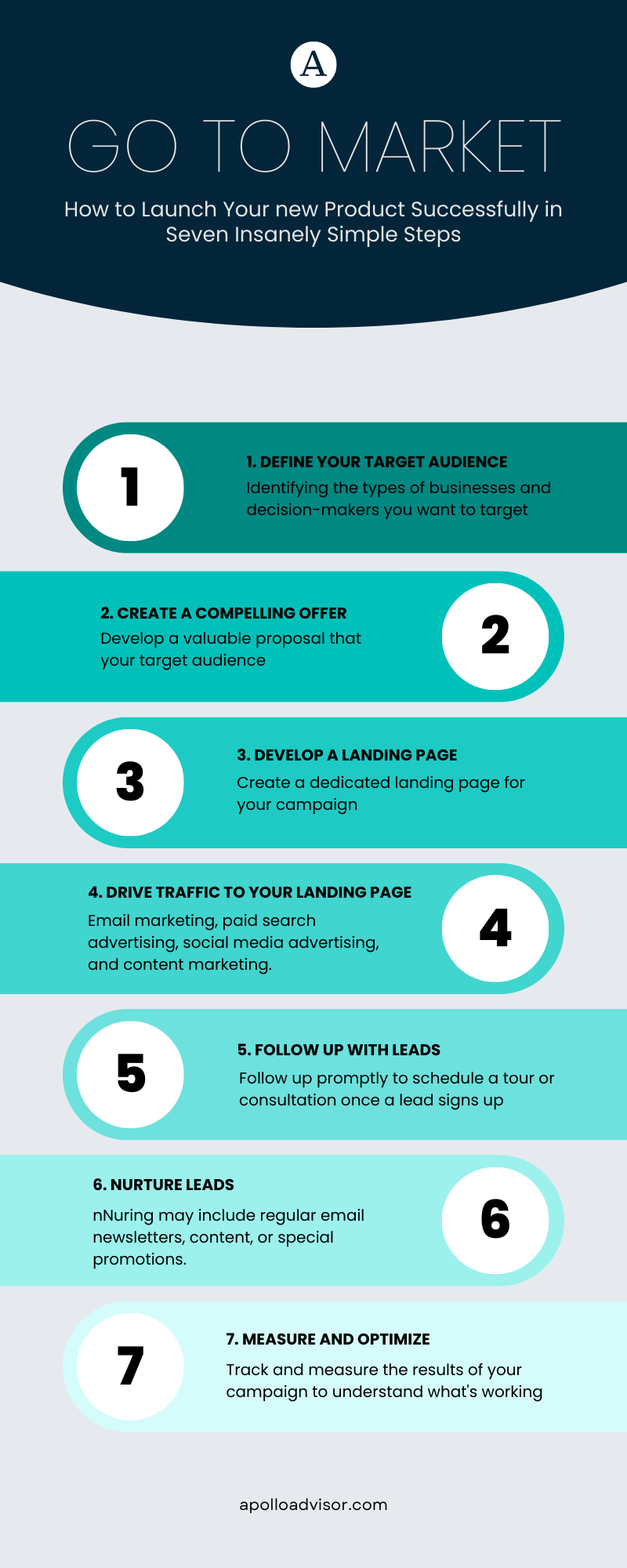How to Launch Your New Product Successfully in Seven Insanely Simple Steps
Seven steps and infographic including defining the target audience, compelling offer, landing page, driving traffic, follow up, nurture, measure and optimize.

Building a brand-new product is an exhausting experience with long days and sleepless nights, followed by another step that can feel like a marathon. While I can't make it easy, I can share some simple steps to follow while you launch your product.
I like to call the Go-To-Market (GTM), and if you follow these seven steps, you'll build momentum and enter a thrilling new stage where your product is live to the world.
A Go-To-Market campaign is essentially a strategic plan for introducing a new product or service to the market. It involves a series of marketing and advertising activities designed to create awareness, generate interest, and ultimately drive sales.
A go-to-market campaign is a crucial part of that strategy because it allows us to focus our marketing efforts on a specific target market and communicate the unique value proposition of your product or service to that market.
Ultimately, a successful go-to-market campaign can help you establish your product or service as a leader in the market and drive significant revenue growth for your business.
Go To Market in 7 Step by Step
I will use a B2B example here, but these steps work nicely for B2C. The only difference is that you would focus on conversion to sale in step six.
- Define your target audience: Start by identifying the types of businesses and decision-makers you want to target with your campaign. Template: Buyer personas
- Create a compelling offer: Develop a valuable proposal that your target audience would be interested in, such as a free trial or discounted membership. This proposal can be the key driver of your lead generation campaign. Template: Value Proposition Canvas
- Develop a landing page: Create a dedicated landing page for your campaign where you can send traffic from your marketing efforts. Template: Hubspot
- Drive traffic to your landing page: Use a variety of marketing tactics to drive traffic to your landing page, such as email marketing, paid search advertising, social media advertising, and content marketing.
- Follow up with leads: Follow up promptly to schedule a tour or consultation once a lead signs up. Use a customer relationship management (CRM) tool to track and manage your leads and ensure they receive timely follow-up.
- Nurture leads: Not all leads will be ready to buy immediately, so developing a lead nurturing strategy is essential to keep them engaged and interested in your gym. This nurturing may include regular email newsletters, educational content, or special promotions. Note that a B2C e-commerce would focus on sales conversion here.
- Measure and optimize: Finally, track and measure the results of your campaign to understand what's working and what's not. Use this data to optimize your campaign and improve your lead-generation efforts.

The Go-To-Market (GTM) strategy is crucial for new products because it outlines a plan for introducing and promoting the product to the target audience to maximise its potential for market success. By defining the target market, setting marketing objectives, and outlining the tactics for achieving those objectives, a GTM strategy helps businesses generate awareness, generate interest, and drive sales.
A well-executed GTM strategy enables a business to differentiate its product from the competition, establish a strong brand identity, and create a positive first impression among customers. It helps companies to develop and communicate a clear and compelling value proposition that resonates with the target audience.
Additionally, a GTM strategy allows businesses to identify and address potential barriers to adoption and create a feedback loop that helps to optimize the approach over time continuously. Ultimately, a successful GTM strategy can lead to increased revenue, market share, and long-term success for the business.

